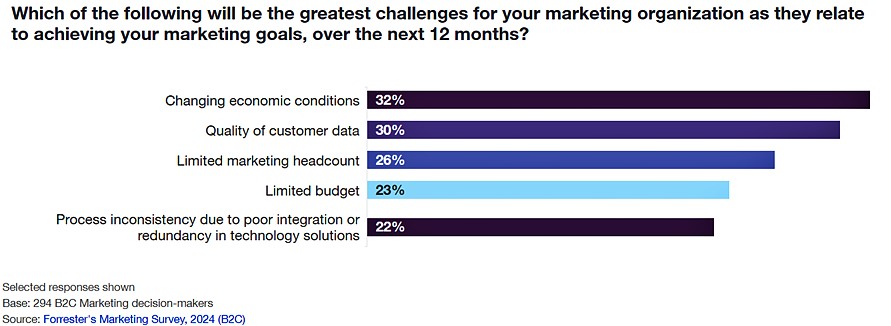Legacy martech dragging on performance, CMOs trapped in cycle of duplicative, labor-intensive effort; fixing it will be tough as boards freeze spend in tight economy, says Forrester

Forrester's Xiaofeng Wang and Rusty Warner
Legacy martech is not delivering the kinds of returns organisations want, and boards are reticent to keep filling the funding budget at a time of significant market constraint, according to a new study by technology research firm Forrester. Getting the balance right is an even tougher assignment for APAC marketers who face even greater challenges than their North American and European peers. Martech can no longer stand alone as self-service capabilities that CMOs license from multiple SaaS vendors using their operating budgets, say the analysts who warn that even the most well-thought-out independent martech stack is no match for a well-integrated technology ecosystem that includes martech capabilities as core components.
Compared to their peers in North America and Europe, APAC marketers face greater challenges with limited marketing headcount, budget, and changing economic conditions. They also contend with a larger and more diverse consumer base, a more complex digital and martech ecosystem, and fragmented privacy regulations.
Marketers need to stop simply layering new tech components on top of old legacy messaging systems. Instead, they need a new approach that addresses rapidly changing market factors and evolving requirements, says Forrester Research in its just-released Future of Marketing Technology Report.
The problem is that while legacy martech is not delivering, boards are reticent to spend more on what is already historically high levels of martech investment.
And it's an even tougher assignment in the APAC region according to Forrester Analyst, Xiaofeng Wang. "Compared to their peers in North America and Europe, APAC marketers face greater challenges with limited marketing headcount, budget, and changing economic conditions," per Wang. "They also contend with a larger and more diverse consumer base, a more complex digital and martech ecosystem, and fragmented privacy regulations."
Wang told Mi3 that to deliver more with fewer resources, CMOs in APAC should: Pursue martech rationalisation to increase marketing efficiency and improved ROI. With a variety of global, regional, and local players, both digital and tech ecosystems are more complicated in APAC. With the marketing budget and resource constraint, APAC marketers should optimise the value of martech investments through improved integration and reduced redundancy. First, identify the gaps between business priorities and martech resources. Second, prioritise martech efforts based on functionality and adoption. Third, use business, operational, and customer metrics to measure martech success."
Wang also stressed that it is important for marketers to navigate fragmented privacy regulations and localise a privacy-first marketing approach. "Facing varied privacy regulatory frameworks across the region is a unique challenge for APAC marketers. Some countries, like Australia, Japan, Korea, New Zealand, and Singapore, have mature privacy regimes. Others, such as China, Thailand, and Indonesia, have recently implemented comprehensive privacy laws."
Likewise, India and Vietnam have just launched their data privacy laws in 2023 she noted. "Consumer data privacy sensitivity and willingness to share personal information also vary greatly across the region. CMOs should carefully take these differences into account when developing regional and local marketing programs."
Tighter privacy laws have also coincided with the deprecation of third-party cookies, firstly on Safari, and now (ongoing with Chrome) increasingly the importance brands assign to first-party data.
But it's an area where marketers in this region are lagging and this, according to Wang, is leading to a gap between data collection and usage. "The region is seeing a growing adoption of tools like Customer Data Platforms to improve the utilisation of first-party data. Moreover, the region's mobile-first consumer ecosystem presents a great opportunity for marketers to leverage zero-party data. Generative AI represents an opportunity for marketers to better harness data for analytics and insights."
Many CMOs strive to be independent of IT, and they may even recreate their own shadow IT capabilities to support their technology requirements. That’s a mistake.
According to her colleague Rusty Warner, VP and principal analyst, Forrester, current martech stacks lead to inconsistent cross-channel orchestration.
"For example, the customer profiles and technologies used to support email campaigns may lag real-time [or real-world] customer behavior, so customers receive irrelevant offers and promotions."
"That will likely be inconsistent with recommendations that customers see when they visit the website, ecommerce site, or mobile app – which may be more up-to-date in some cases but may also be inconsistent with one another. And of course, we’ve all received ads for products based on our browsing behavior, even if we’ve already purchased the product in question, possibly even from the brands that paid for the ads."
Warner said that while it's obvious that marketers want to deliver consistent promotions that are contextually relevant to individual customers, there’s a lot of work to be done to reconcile current martech ecosystems to achieve that.
Shadow IT
He also noted that many CMOs strive to be independent of IT, and they may even recreate their own shadow IT capabilities to support their technology requirements. That’s a mistake, he said.
"Of course, there have been issues with marketing and IT collaboration, especially since marketing is often viewed as a nice-to-have cost center for product promotion versus a critical business driver. That’s changing as marketing becomes more embedded in customer experience strategies. Such mission criticality is driving the need for martech to be deeply integrated into the overall technology ecosystem."
Warner says that martech can no longer stand alone as self-service capabilities that CMOs license from multiple SaaS vendors using their operating budgets. "Even the most well-thought-out independent martech stack is no match for a well-integrated technology ecosystem that includes martech capabilities as core components."
Mi3 also asked Warner what gets in the way of value realisation, a common CMO gripe about martech.
"Marketers use a set of metrics that help them understand their return on marketing investments (ROMI), but those insights may not align with overall business objectives. Marketers even make the mistake of conflating customer lifetime value (CLV) with customer lifetime revenue or cumulative orders."
In reality, he said, CLV is a forward-looking profit contribution model that looks at the next three years (long-term) or the next one year to 18 months (short-term).
"It considers potential revenue, survival [retention], acquisition costs, and servicing costs, using a financially robust algorithm to factor in time and discount rates [future value of money]. CLV requires marketers to collaborate with the CFO, data science teams, and other customer-facing functions. Failure to think about marketing’s business impact sees them continuing to invest in martech to drive acquisition and conversions without being seen as core to the business."
He told Mi3, "That’s why many organisations cut marketing budgets in the face of an economic downturn when they should be investing."
It's a strategy that can lead to disaster, per Warner.
He cited the example of a a UK retail brand’s marketing team which ran incredibly successful campaigns that drove higher revenue. "But unfortunately, their promotions were not aligned with inventory and stock levels for high-margin products. The brand saw profits decline because of excess inventory for goods they were not selling and reduced margins for goods they had to order unexpectedly to fill demand that was not part of their forecast."
According to Warner, "They ended up cutting marketing budgets and staff. So, all those martech investments that drove promotional campaigns did not pay off because they were not aligned with the business."
Forrester's analysts also believe that marketers mistakenly conflate several basic customer experience concepts.
Per Warner, "First of all, they conflate personalisation with customer experience. Personalisation is usually a promotional tactic, whereas customer experience is the customer’s overall perception of the brand, based on all their interactions. Personalisation can be more aligned with customer experience, but only if investments apply across the entire customer lifecycle, not just to acquisition and conversion activities."
Secondly, he says, they conflate campaign workflows with customer journeys. "The former is marketing’s plan for how they are going to engage with customers, and the latter is how customers will achieve their goals or realise value – including their interactions with a brand, but their interactions with every other brand, the market, society in general, friends, family, etc."
"Marketers too often invest in martech to drive their own inside-out view of what they think customers want. That means their investments in personalisation and what marketers call customer journeys will usually fall flat, unless they consider more holistic personalisation across the entire customer lifecycle and truly understand customer journeys from the outside-in perspective."
Both will require martech integration with the rest of the CX ecosystem, including sales, ecommerce, service, and supporting operational functions, he said.

Key report findings
Among the key issues that the Forrester Report says martech needs to address:
- Customer-first data strategies. The forces of data deprecation force marketers to update their data strategies to focus on first- and zero-party data and data privacy. They need tech that collects customer data and aligns it with enterprise data, resolves customer identities, and generates robust customer profiles
- Personalisation: Consumer attitudes toward personalisation are nuanced, and delivering relevant, timely, and channel-agnostic experiences is a technical puzzle many have yet to solve. No single technology will solve for the personalisation mandate but rather multiple technologies working together
- Expectations: A turbulent economic environment puts martech spending under a microscope, as new investments require a more robust business case and companies look to eliminate redundant or underutilised capabilities.
- Get out of the Silo. CMOs need to recognise they are part of a broader CX family of customer-facing touchpoints like sales, service, and digital Marketers must invest in high-performance systems that prioritise scalability and speed to handle the volume and speed of required decisions and delivery.
Legacy martech is a drag on performance with difficult and expensive integration challenges inefficient automation and access leaves marketers Marketers are trapped in a cycle of duplicative, labour-intensive effort as they build ad hoc data sets for each campaign, manually move data across systems, and recreate the same objects in multiple tools, and CMO are often reliant on martech stacks that never seriously anticipated the volume and velocity that today’s customer engagement requires.
Marketers must embrace the unbundling of martech and adopt a new strategy to shift away from supporting legacy channel-centric, campaign-oriented tactics to channel agnostic, journey-oriented engagement.


